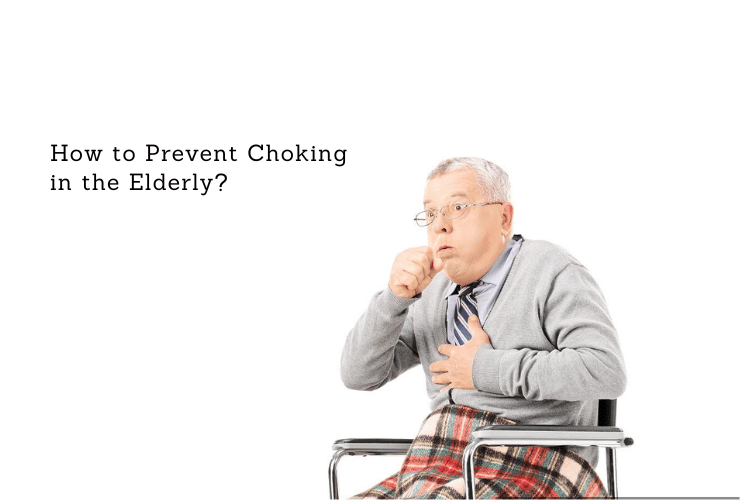
Choking is a serious and potentially life-threatening issue, especially in the elderly. Age-related physical changes, medical conditions, and environmental factors can all increase the risk of choking among seniors. Whether you’re a caregiver, family member, or part of a healthcare team, understanding how to prevent choking is vital for ensuring both safety and quality of life. This comprehensive guide will provide detailed insights into the causes, prevention strategies, emergency response techniques, and long-term management of choking risks in elderly adults.
Understanding the Causes of Choking in the Elderly
To effectively prevent choking, it's crucial to understand what causes it. Choking happens when food or another object becomes lodged in the airway, blocking airflow. The elderly are particularly at risk due to the following factors:
1. Dysphagia (Difficulty Swallowing)
Dysphagia, a condition characterized by impaired swallowing, often stems from neurological disorders such as stroke, Parkinson's disease, and Alzheimer's. It disrupts the ability to move food or liquid from the mouth to the stomach, causing an increased risk of airway obstruction. Dysphagia is especially dangerous because it can lead to silent aspiration (where food or liquid enters the airway without triggering a cough), compounding the risk of respiratory complications.
2. Dental Issues
Missing teeth, poorly fitting dentures, or general dental problems can make chewing difficult. Improperly chewed food increases the chances of choking. Seniors with dental issues may inadvertently swallow large or unprocessed pieces of food, leading to blockages in the throat or airway.
3. Reduced Saliva Production
Age or medication-induced dry mouth reduces saliva production, making food harder to chew and swallow. Saliva is essential in softening food and lubricating the throat to ease the swallowing process.
4. Cognitive Impairments
Neurological conditions such as dementia and Alzheimer’s can impair memory and judgment, causing elderly individuals to eat too quickly or take large bites. Additionally, confusion during mealtimes can lead to attempting to swallow non-food items, such as small utensils or napkins.
5. Choking Hazards in Care Facilities
Nursing homes and care facilities can present unique risks:
- Lack of Supervision: During meals, residents with swallowing difficulties may not receive adequate attention, increasing the likelihood of choking incidents.
- Improperly Prepared Meals: Serving food with complex textures or failing to follow swallowing-safe dietary guidelines can cause blockages.
- Dehydration and Malnutrition: These common issues worsen swallowing difficulties, increasing the risk of choking and aspiration.
- Haste During Meals: Limited supervision often means meals are rushed, preventing proper chewing and swallowing.
By recognizing these causes, caregivers can take targeted steps to minimize the risk of choking.
Practical Strategies to Prevent Choking
Preventative care begins with modifying the eating environment, food preparation, and supervision techniques. Below are detailed strategies for reducing choking risks:
1. Modify Food Texture
Altering food texture is one of the most effective ways to prevent choking:
- Prepare soft or puréed foods for easier swallowing.
- Steam or mash vegetables until tender.
- Avoid foods with mixed textures, such as chunky soups, which can confuse the swallowing reflex.
- Stay away from small, hard foods like nuts, raw carrots, and popcorn.
2. Promote Proper Eating Habits
Encourage elderly individuals to:
- Eat slowly and use small bites.
- Chew food thoroughly to ensure easier swallowing.
- Maintain an upright position before, during, and after meals (for at least 30 minutes post-meal). This reduces the risk of food or liquid entering the airway.
3. Use Assistive Devices
Specialized utensils and tools can make meals safer:
- Cups with spouts or straws to control liquid intake.
- Forks and spoons with ergonomic handles for those with limited dexterity.
- Plate guards and food bumpers to help scoop food more efficiently.
4. Monitor Medications
Some medications can cause drowsiness, dry mouth, or weakened reflexes, increasing choking risks. Review prescriptions with a healthcare provider to assess side effects and explore alternatives if needed.
5. Create a Safe Eating Environment
Provide a distraction-free environment during meals:
- Turn off TVs or background noise to encourage focus.
- Serve meals in relaxed, well-lit spaces where the senior feels comfortable.
6. Incorporate Thickened Liquids
For individuals with dysphagia, using liquid thickeners can make swallowing safer. Thicker liquids are easier to control and less likely to cause aspiration.
Addressing Choking Incidents: What to Do
Even with prevention strategies, choking incidents can still occur. Knowing how to respond calmly and effectively can save lives.
1. Recognizing the Signs
Early recognition is critical. Common indicators of choking include:
- Difficulty breathing or speaking.
- Coughing or wheezing.
- Clutching the throat.
- Bluish discoloration (cyanosis) around the face or lips.
- Complete silence if the airway is entirely blocked.
2. Performing the Heimlich Maneuver
The Heimlich maneuver, or abdominal thrusts, is a vital skill to dislodge food or objects from the airway. Here’s how to do it:
-
For a standing individual:
- Stand behind them and wrap your arms around their waist.
- Make a fist with one hand and place it just above their navel.
- Grasp your fist with the other hand and press sharply inward and upward.
- Repeat until the object is expelled.
-
For wheelchair-bound or frail seniors:
- Adapt the technique by standing or kneeling behind the chair.
- Use gentler but firm movements to avoid injury.
3. Calling for Emergency Help
If choking persists or the individual loses consciousness:
- Call emergency services immediately.
- Transition to CPR if the person is not breathing.
Post-Choking Care and Recovery
Following a choking incident, it’s essential to address potential complications and focus on recovery strategies.
1. Potential Complications
Choking may result in injuries such as vocal cord damage or aspiration pneumonia. Symptoms to watch for include:
- Persistent coughing or hoarseness.
- Difficulty breathing.
- Fever or fatigue.
2. Long-Term Recovery Steps
- Seek follow-up care with a speech-language pathologist to assess and treat swallowing difficulties.
- Modify the individual’s diet further based on their needs.
- Rebuild confidence during meals with supervision and reassurance.
Understanding Aspiration and Its Risks
Aspiration occurs when food, liquid, or saliva enters the lungs instead of the stomach. This can lead to dangerous complications like aspiration pneumonia.
How to Prevent Aspiration
- Provide appropriate food textures and avoid thin liquids unless thickened.
- Ensure the individual is seated upright during and after meals.
- Supervise meals for individuals with dysphagia.
Frequently Asked Questions
Q: What should I do to prevent choking in elderly adults with dysphagia?
A: To prevent choking, ensure the elderly can adequately chew their food by providing appropriately sized pieces. Monitor their eating habits and encourage them to eat slowly. Additionally, thickened liquids should be considered to reduce the risk of aspiration pneumonia.
Q: How can I recognize if a loved one is choking?
A: Choking occurs when food or a foreign object obstructs the airway. Signs include difficulty breathing, coughing, inability to speak, or a look of panic. If the person can cough, encourage them to continue, which may help dislodge the obstruction.
Q: What are the risks associated with choking for elderly people?
A: Choking can lead to serious complications such as brain damage due to lack of oxygen, aspiration pneumonia, or even death. Act quickly if choking occurs is crucial to prevent these severe outcomes.
Q: What type of food is safer for elderly adults with dysphagia?
A: Foods that are easy to chew and swallow, such as soft fruits, cooked vegetables, and ground meats, are safer. Avoid harsh, dry, or hard foods that require extensive chewing, as these can increase the risk of choking.
Q: How can I help an elderly person if they start to choke?
A: If a choking person cannot cough or speak, perform the Heimlich maneuver, focusing on compressing the abdomen just above the navel. If the obstruction does not dislodge, call emergency services immediately and be prepared to perform cardiopulmonary resuscitation (CPR) if they become unresponsive.
Q: How does Parkinson’s disease affect swallowing in elderly adults?
A: Parkinson’s disease can cause dysphagia, making it difficult for individuals to chew and swallow food properly. This can increase the risk of choking and aspiration, necessitating special dietary considerations and close monitoring during meals.
Q: What adjustments can be made to reduce dysphagia in the elderly?
A: To reduce dysphagia, thickening liquids and providing foods that require minimal chewing is beneficial. Additionally, positioning the individual upright during meals can aid in swallowing and reduce the risk of choking.
Q: What should I do if a choking person loses consciousness?
A: If the choking person loses consciousness, immediately call emergency services. Begin CPR, ensuring to check the mouth for any foreign object before giving breaths, as this may help dislodge the obstruction.
Q: Can a denture affect the risk of choking in elderly adults?
A: Ill-fitting dentures can hinder proper chewing and swallowing, increasing the risk of choking. It is essential for elderly individuals with dentures to have them fitted correctly and to practice good oral hygiene.
Q: What are the common causes of choking among older adults?
A: Common causes of choking in older adults include swallowing difficulties due to dysphagia, consuming large pieces of food, or not chewing food adequately. Additionally, certain medical conditions like Alzheimer’s can also contribute to the risk of choking.
Conclusion
Preventing choking in the elderly requires a proactive approach, combining dietary adjustments, proper supervision, and knowledge of emergency response techniques. By understanding the causes of choking, implementing practical strategies, and preparing for emergencies, caregivers can ensure the safety and well-being of their loved ones. These measures enable seniors to enjoy their meals with peace of mind, leading to a healthier and more fulfilling life.








 Login with Google
Login with Google Login with Facebook
Login with Facebook